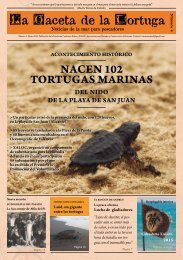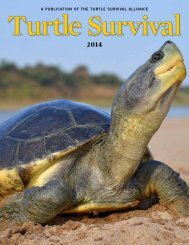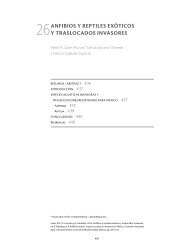tsrp63entire
tsrp63entire
tsrp63entire
Create successful ePaper yourself
Turn your PDF publications into a flip-book with our unique Google optimized e-Paper software.
feed until after metamorphosis (Bell 1985). Hochstetter’s frogs have been recorded at densities of<br />
65–140 per 100 m 2 in the Waitakere Ranges (Slaven 1992); 5–12 per 100 m 2 in the<br />
Hunua Ranges (Greene & Tessier 1990); and 18–21 per 100 m 2 at Golden Cross Mine in the<br />
Coromandel (Whitaker 1996; Whitaker & Alspach 1999).<br />
Maud Island frog and Hamilton’s frog are the largest living leiopelmatid frogs (SVL up to<br />
51 mm). Both species are currently found amongst the boulders and moss-covered rocks in<br />
terrestrial areas of remnant and regenerating coastal forests. Like Archey’s frog, they are<br />
terrestrial breeders. However, their breeding behaviour, egg laying and parental care have only<br />
been observed in captivity. Maud Island frogs are considered to be numerous on Maud Island,<br />
reaching densities of 70–230 per 100 m 2 (Bell 1997). Hamilton’s frogs have been recorded at<br />
densities of 53–58 per 100 m 2 (Newman 1990; Thomson 1997), although, based on modelling, they<br />
were estimated to have increased dramatically to 220 per 100 m 2 in 2004 (Tocher et al. 2006).<br />
3.1.3 Status and species recovery phases<br />
In recovery planning for threatened species, the Department of Conservation (DOC) has<br />
adopted a model that identifies four phases of recovery action: ‘Research’ to identify causes and<br />
key agents of decline; ‘Secure’ the taxon from extinction; ‘Recovery’; and ‘Maintenance’. There<br />
remains some uncertainty about the causes and key agents of decline for native frogs and the<br />
threats to both Archey’s and Hochstetter’s frogs still need to be identified. Given this, the plan is<br />
largely focused on the first two phases of recovery—research and secure. Less focus is placed on<br />
Maud Island and Hamilton’s frogs, as they are considered to be in the recovery and maintenance<br />
phases, as previous management has resulted in additional populations being established so<br />
that both species are now considered secure from extinction as long as the populations remain<br />
protected from agent(s) of decline. The national and international threat classifications, and the<br />
current phase of recovery for native frog species are listed in Table 1.<br />
3.1.4 Past and present distribution<br />
Subfossil remains indicate that Leiopelma species were once widely distributed throughout<br />
New Zealand. Subfossil frog bones have been dated at between 200 and 2000 years BP, and it<br />
is thought that the extinction of these frogs may be correlated with the arrival of the Pacific rat<br />
(kiore, Rattus exulans) in New Zealand (Worthy 1987a, b). Remains identified as Hamilton’s and<br />
Hochstetter’s frogs have been discovered on both the South and North Islands (Worthy 1987a, b);<br />
and Leiopelmatidae fossils and a second frog taxon that had not previously been recorded in<br />
New Zealand were recently discovered in Central Otago (Worthy et al. 2009).<br />
All native frog species appear to have reduced distributions and exist in remnant populations<br />
(Fig. 1). Information on the past and present distribution of native frog species has been collated<br />
in DOC’s Atlas of Amphibians and Reptiles of New Zealand (DOC 2009).<br />
Table 1.<br />
Threat classification/status and phase of recovery for native frogs (Leiopelma spp.).<br />
Species name<br />
NZ Threat<br />
Classification<br />
(Newman et al. 2013)<br />
IUCN status<br />
(IUCN 2012;<br />
Version 2012.2)<br />
Phase(s) of species<br />
recovery<br />
(from DOC 2008)<br />
Archey’s frog Nationally Vulnerable Critically Endangered Identify agent(s) of decline<br />
Secure the taxon<br />
Hochstetter’s frog At risk—Declining Vulnerable Identify agent(s) of decline<br />
Secure the taxon<br />
Maud Island frog Nationally Vulnerable Vulnerable Secure the taxon<br />
Hamilton’s frog Nationally Critical Endangered Secure the taxon<br />
4 Bishop et al.—Native frog recovery plan, 2013–2018





